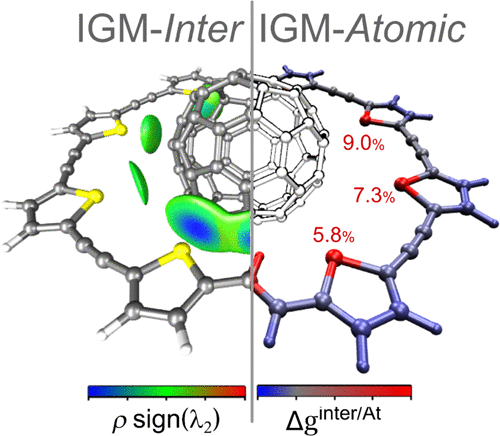当前位置:
X-MOL 学术
›
J. Chem. Inf. Model.
›
论文详情
Our official English website, www.x-mol.net, welcomes your
feedback! (Note: you will need to create a separate account there.)
Atomic Decomposition Scheme of Noncovalent Interactions Applied to Host-Guest Assemblies.
Journal of Chemical Information and Modeling ( IF 5.6 ) Pub Date : 2020-01-13 , DOI: 10.1021/acs.jcim.9b01016 Miguel Ponce-Vargas 1 , Corentin Lefebvre 1 , Jean-Charles Boisson 2 , Eric Hénon 1
Journal of Chemical Information and Modeling ( IF 5.6 ) Pub Date : 2020-01-13 , DOI: 10.1021/acs.jcim.9b01016 Miguel Ponce-Vargas 1 , Corentin Lefebvre 1 , Jean-Charles Boisson 2 , Eric Hénon 1
Affiliation

|
The design of novel stimuli-responsive supramolecular systems based on host-guest chemistry implies a thorough understanding of the noncovalent interactions involved. In this regard, some computational tools enabling the extraction of the noncovalent signatures from local descriptors based on the electron density have been previously proposed. Although very useful to detect the existence of such interactions, these analyses provide only a semi-quantitative description, which represents a limitation. In this work, we present a novel computational tool based on the local atomic descriptor IGM-δginter/At, which is able to decompose the fragment interaction into atomic contributions. Then, the role played by each atom in the formation of the host-guest assembly is quantified by an integrated Δginter/At score. Herein, we apply the IGM-Δginter/At approach to some challenging systems, including multimetallic arrays, buckycatchers, and organic assemblies. These systems exhibit unique structural features that make it difficult to determine the host/guest atoms that contribute the most to the guest encapsulation. Here, the Δginter/At score proves to be an appealing tool to shed light on the guest accommodation on a per-atom basis and could be useful in the rational design of more selective target agents. We strongly believe that this novel approach will be useful for experimental teams devoted to the synthesis of supramolecular systems based on host-guest chemistry.
中文翻译:

非共价相互作用的原子分解方案应用于宿主-来宾程序集。
基于宿主-客体化学的新型刺激响应性超分子系统的设计意味着对所涉及的非共价相互作用的透彻理解。在这方面,先前已经提出了一些计算工具,该计算工具使得能够基于电子密度从局部描述符中提取非共价标记。尽管这些分析对于检测此类交互的存在非常有用,但它们仅提供了半定量描述,这代表了一种局限性。在这项工作中,我们提出了一种基于局部原子描述符IGM-δginter/ At的新颖计算工具,该工具能够将碎片相互作用分解为原子贡献。然后,通过积分Δginter/ At分数来量化每个原子在主客体组装体形成中所起的作用。在此处,我们将IGM-Δginter/ At方法应用于一些具有挑战性的系统,包括多金属阵列,诱捕器和有机组件。这些系统具有独特的结构特征,这使得很难确定对客体封装贡献最大的主体/客体原子。在此,Δginter/ At分数被证明是一个吸引人的工具,可以让每个原子了解客人的住宿情况,并且在合理设计更具选择性的目标药物方面可能很有用。我们坚信,这种新颖的方法将对致力于基于客体-客体化学的超分子系统合成的实验团队有用。这些系统具有独特的结构特征,这使得很难确定对客体封装贡献最大的主体/客体原子。在这里,Δginter/ At分数被证明是一个吸引人的工具,可以阐明每个原子上的宾客住宿情况,并且可以在合理设计更具选择性的目标药物中使用。我们坚信,这种新颖的方法将对致力于基于客体-客体化学的超分子系统合成的实验团队有用。这些系统具有独特的结构特征,这使得很难确定对客体封装贡献最大的主体/客体原子。在此,Δginter/ At分数被证明是一个吸引人的工具,可以让每个原子了解客人的住宿情况,并且在合理设计更具选择性的目标药物方面可能很有用。我们坚信,这种新颖的方法将对致力于基于客体-客体化学的超分子系统合成的实验团队有用。
更新日期:2020-01-14
中文翻译:

非共价相互作用的原子分解方案应用于宿主-来宾程序集。
基于宿主-客体化学的新型刺激响应性超分子系统的设计意味着对所涉及的非共价相互作用的透彻理解。在这方面,先前已经提出了一些计算工具,该计算工具使得能够基于电子密度从局部描述符中提取非共价标记。尽管这些分析对于检测此类交互的存在非常有用,但它们仅提供了半定量描述,这代表了一种局限性。在这项工作中,我们提出了一种基于局部原子描述符IGM-δginter/ At的新颖计算工具,该工具能够将碎片相互作用分解为原子贡献。然后,通过积分Δginter/ At分数来量化每个原子在主客体组装体形成中所起的作用。在此处,我们将IGM-Δginter/ At方法应用于一些具有挑战性的系统,包括多金属阵列,诱捕器和有机组件。这些系统具有独特的结构特征,这使得很难确定对客体封装贡献最大的主体/客体原子。在此,Δginter/ At分数被证明是一个吸引人的工具,可以让每个原子了解客人的住宿情况,并且在合理设计更具选择性的目标药物方面可能很有用。我们坚信,这种新颖的方法将对致力于基于客体-客体化学的超分子系统合成的实验团队有用。这些系统具有独特的结构特征,这使得很难确定对客体封装贡献最大的主体/客体原子。在这里,Δginter/ At分数被证明是一个吸引人的工具,可以阐明每个原子上的宾客住宿情况,并且可以在合理设计更具选择性的目标药物中使用。我们坚信,这种新颖的方法将对致力于基于客体-客体化学的超分子系统合成的实验团队有用。这些系统具有独特的结构特征,这使得很难确定对客体封装贡献最大的主体/客体原子。在此,Δginter/ At分数被证明是一个吸引人的工具,可以让每个原子了解客人的住宿情况,并且在合理设计更具选择性的目标药物方面可能很有用。我们坚信,这种新颖的方法将对致力于基于客体-客体化学的超分子系统合成的实验团队有用。











































 京公网安备 11010802027423号
京公网安备 11010802027423号